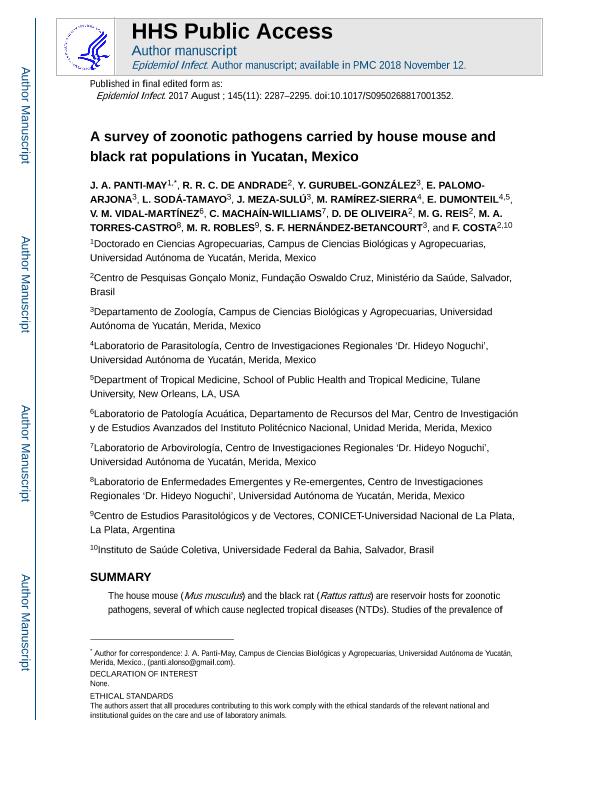Artículo
A survey of zoonotic pathogens carried by house mouse and black rat populations in Yucatan, Mexico
Panti May, J. A.; de Andrade, R. R. C.; Gurubel González, Y.; Palomo Arjona, E.; Sodá Tamayo, L.; Meza Sulú, J.; Ramírez Sierra, M.; Dumonteil, E.; Vidal Martínez, V. M.; Machaín Williams, C.; de Oliveira, D.; Reis, M. G.; Torres Castro, M. A.; Robles, Maria del Rosario ; Hernández Betancourt, S. F.; Costa, F.
; Hernández Betancourt, S. F.; Costa, F.
 ; Hernández Betancourt, S. F.; Costa, F.
; Hernández Betancourt, S. F.; Costa, F.
Fecha de publicación:
08/2017
Editorial:
Cambridge University Press
Revista:
Epidemiology and Infection
ISSN:
0950-2688
Idioma:
Inglés
Tipo de recurso:
Artículo publicado
Clasificación temática:
Resumen
The house mouse (Mus musculus) and the black rat (Rattus rattus) are reservoir hosts for zoonotic pathogens, several of which cause neglected tropical diseases (NTDs). Studies of the prevalence of these NTD-causing zoonotic pathogens, in house mice and black rats from tropical residential areas are scarce. Three hundred and two house mice and 161 black rats were trapped in 2013 from two urban neighbourhoods and a rural village in Yucatan, Mexico, and subsequently tested for Trypanosoma cruzi, Hymenolepis diminuta and Leptospira interrogans. Using the polymerase chain reaction we detected T. cruzi DNA in the hearts of 4.9% (8/165) and 6.2% (7/113) of house mice and black rats, respectively. We applied the sedimentation technique to detect eggs of H. diminuta in 0.5% (1/182) and 14.2% (15/106) of house mice and black rats, respectively. Through the immunofluorescent imprint method, L. interrogans was identified in 0.9% (1/106) of rat kidney impressions. Our results suggest that the black rat could be an important reservoir for T. cruzi and H. diminuta in the studied sites. Further studies examining seasonal and geographical patterns could increase our knowledge on the epidemiology of these pathogens in Mexico and the risk to public health posed by rodents.
Archivos asociados
Licencia
Identificadores
Colecciones
Articulos(CEPAVE)
Articulos de CENTRO DE EST.PARASITOL.Y DE VECTORES (I)
Articulos de CENTRO DE EST.PARASITOL.Y DE VECTORES (I)
Citación
Panti May, J. A.; de Andrade, R. R. C.; Gurubel González, Y.; Palomo Arjona, E.; Sodá Tamayo, L.; et al.; A survey of zoonotic pathogens carried by house mouse and black rat populations in Yucatan, Mexico; Cambridge University Press; Epidemiology and Infection; 145; 11; 8-2017; 2287-2295
Compartir
Altmétricas



